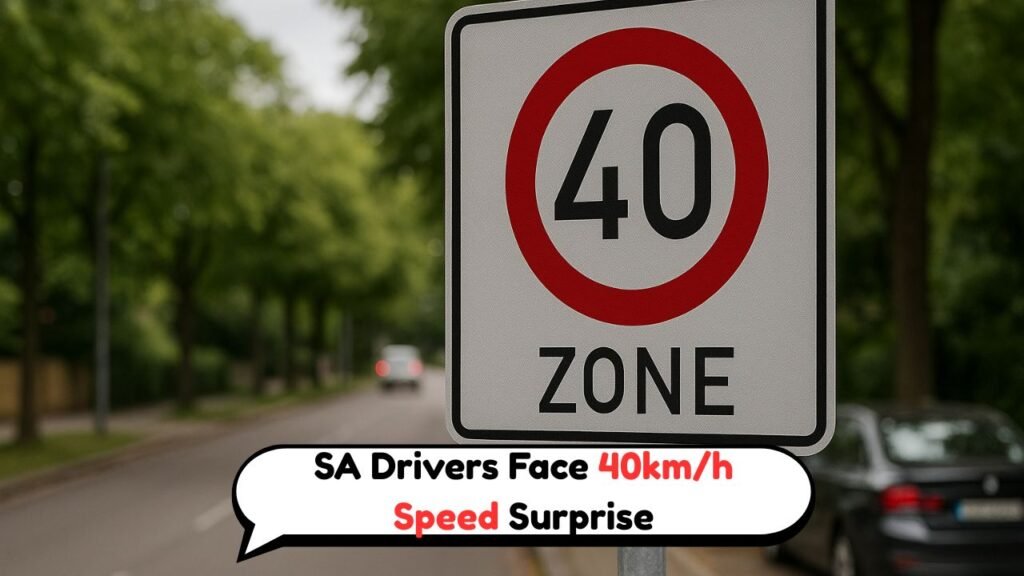40km/h Speed Limits in South Africa: As South Africa continues to prioritize road safety, a significant change is on the horizon for local drivers. By October 2025, specific areas will see the implementation of a 40km/h speed limit, a move aimed at reducing accidents and ensuring the safety of all road users. This initiative is part of a broader effort to align with global road safety standards, focusing on high-density pedestrian zones, school vicinities, and areas with a history of traffic incidents. With urban areas becoming increasingly congested, this measure is expected to enhance the quality of life by creating safer environments for both pedestrians and drivers. This change will require drivers to be more vigilant and adjust their driving habits to accommodate the new speed restrictions.

Understanding the New Speed Limit Zones in South Africa
The introduction of the 40km/h speed limit in specific South African areas is a strategic move to enhance road safety. These zones will primarily include urban centers, residential areas, and locations with high pedestrian traffic. By focusing on these areas, the government aims to decrease the risk of accidents, which are often exacerbated by higher speeds in congested zones. The implementation will be accompanied by clear signage and public awareness campaigns to ensure that drivers are well-informed about the changes. Local authorities will also work to identify and address any infrastructural needs, such as improved road markings and pedestrian crossings, to further support this initiative. Drivers should expect increased law enforcement presence in these areas to monitor compliance and ensure that the new speed limits are adhered to. As South Africa moves towards this change, motorists are encouraged to stay informed and participate in community discussions about road safety improvements.
Impact of the 40km/h Speed Limit on Road Safety
The decision to implement a 40km/h speed limit in specific areas is expected to have a profound impact on road safety across South Africa. Studies from other countries have shown that reducing speed limits in urban areas can significantly decrease the number of severe accidents. By October 2025, South African cities are anticipated to experience similar benefits. Lower speeds not only reduce the likelihood of collisions but also lessen the severity of accidents that do occur, thereby reducing fatalities and serious injuries. Additionally, slower traffic speeds can create a more pleasant and less stressful environment for both drivers and pedestrians, encouraging more people to walk or cycle, thereby promoting healthier lifestyles. This initiative is a part of a larger framework to achieve Vision Zero—a global campaign aiming for zero road deaths. Community engagement and education will play crucial roles in the successful adoption of these new speed limits, with local governments working alongside residents to ensure a smooth transition.
 Discover the August 2025 SASSA Grants: R2,315, R560, and R1,250 Payouts with Full Calendar Details
Discover the August 2025 SASSA Grants: R2,315, R560, and R1,250 Payouts with Full Calendar Details
Preparing for the 40km/h Speed Limit Rollout in Communities
Communities across South Africa will need to prepare for the upcoming 40km/h speed limit rollout. This preparation involves both infrastructural changes and behavioral adjustments. Local governments will be tasked with installing appropriate signage and road markings, while also ensuring that traffic lights and pedestrian crossings are optimized for the new speed limits. Public awareness campaigns will be crucial in educating drivers about the importance of adhering to the new speed limits and the benefits they bring to community safety. Residents can also play a vital role by participating in local meetings and providing feedback on areas of concern, helping to identify zones that may require additional safety measures. Schools and community centers will also be involved in spreading awareness and educating the younger population about road safety. As October 2025 approaches, ongoing communication between authorities and the public will be essential to fostering a culture of safety and compliance with the new speed regulations.
Future Prospects of Speed Regulation in South Africa
The introduction of 40km/h speed limits in certain areas marks a significant step towards improved road safety in South Africa. Looking to the future, this initiative could pave the way for further advancements in traffic regulation and urban planning. As data is collected and analyzed from the implementation of these new limits, it may reveal additional areas where speed reductions could be beneficial. This could lead to more widespread implementation of lower speed limits, particularly in areas with high accident rates or pedestrian activity. Moreover, the success of this initiative could inspire other measures, such as the introduction of smart traffic management systems and increased investment in public transportation. As South Africa continues to grow and urbanize, adapting to these changes will be essential in ensuring that roads remain safe and accessible for all. The commitment to road safety and the willingness to adopt new strategies reflect a broader vision for a safer, more sustainable future.


